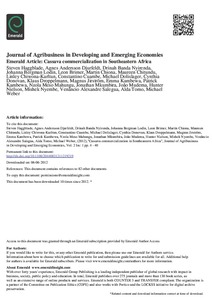| dc.contributor.author | Haggblade, S. |
| dc.contributor.author | Djurfeldt, A. |
| dc.contributor.author | Nyirenda, D. |
| dc.contributor.author | Lodin, J. |
| dc.contributor.author | Brimer, L. |
| dc.contributor.author | Chiona, M. |
| dc.contributor.author | Chitundu, M. |
| dc.contributor.author | Chiwona-Karltun, L. |
| dc.contributor.author | Cuambe, C. |
| dc.contributor.author | Dolislager, M. |
| dc.contributor.author | Donovan, C. |
| dc.contributor.author | Droppelmann, K. |
| dc.contributor.author | Jirstrom, M. |
| dc.contributor.author | Kambewa, E. |
| dc.contributor.author | Kambewa, P. |
| dc.contributor.author | Mahungu, N.M. |
| dc.contributor.author | Mkumbira, J. |
| dc.contributor.author | Mudema, J. |
| dc.contributor.author | Nielson, H. |
| dc.contributor.author | Nyembe, M. |
| dc.contributor.author | Salegua, V. |
| dc.contributor.author | Tomo, A. |
| dc.contributor.author | Weber, M. |
| dc.date.accessioned | 2019-12-04T11:04:22Z |
| dc.date.available | 2019-12-04T11:04:22Z |
| dc.date.issued | 2012 |
| dc.identifier.citation | Haggblade, S., Djurfeldt, A., Nyirenda, D., Lodin, J., Brimer, L., Chiona, M., ... & Kambewa, P. (2012). Cassava commercialization in Southeastern Africa. Journal of Agribusiness in Developing and Emerging Economies, 2(1), 4-40. |
| dc.identifier.issn | 2044-0839 |
| dc.identifier.uri | https://hdl.handle.net/20.500.12478/1410 |
| dc.description.abstract | Purpose – Cassava production surged noticeably in Southeastern Africa beginning in the 1990s. The purpose of this paper is to examine the commercial responses and food security consequences of cassava production growth in the region.
Design/methodology/approach – The paper incorporates a mix of quantitative analysis, based primarily on original analysis of national farmhousehold survey data, together with key informant interviews with value chain participants in the three neighboring countries of Malawi, Mozambique and Zambia.
Findings – In the cassava production zones, cassava’s high productivity translates into per kilogram carbohydrate costs 60 per cent to 70 per cent of the cost of cereals such as maize and wheat, thereby opening up a range of profitable opportunities for commercialization of cassava-based foods, feeds and industrial products. Despite this potential, cassava commercialization in Southeastern Africa remains in its formative stages, with only 10 per cent to 30 per cent of production currently marketed. Unlike West Africa, where cassava commercialization has centered on marketing prepared cassava-based convenience foods, the emerging cassava markets in Southeastern Africa have centered on fresh cassava, low value-added cassava flour, and experiments in industrial processing of cassava-based starches, biofuels and feeds. Strategic investment in a set of key public goods (breeding, training in food sciences and food safety, and research on in-ground cassava storage) can help to shape this transition in ways that benefit both commercial interests and the food security of vulnerable households.
Originality/value – The paper compares cassava commercialization across differing agro-climatic zones, policy environments and food staple zones. |
| dc.description.sponsorship | Swedish International Development Cooperation Agency |
| dc.description.sponsorship | United States Agency for International Development |
| dc.description.sponsorship | Bill & Melinda Gates Foundation |
| dc.format.extent | 4-40 |
| dc.language.iso | en |
| dc.subject | Malawi |
| dc.subject | Mozambique |
| dc.subject | Plants |
| dc.subject | Food Crops |
| dc.subject | Value Chain |
| dc.subject | Cassava |
| dc.subject | Commercialization |
| dc.subject | Food Security |
| dc.subject | Cassava |
| dc.title | Cassava commercialization in Southeastern Africa |
| dc.type | Journal Article |
| dc.description.version | Peer Review |
| cg.contributor.crp | Roots, Tubers and Bananas |
| cg.contributor.affiliation | Michigan State University |
| cg.contributor.affiliation | Lund University |
| cg.contributor.affiliation | University of Zambia |
| cg.contributor.affiliation | University of Copenhagen |
| cg.contributor.affiliation | Zambia Agricultural Research Institute |
| cg.contributor.affiliation | Programme Against Malnutrition, Zambia |
| cg.contributor.affiliation | Swedish University of Agricultural Sciences |
| cg.contributor.affiliation | Instituto de Investigação Agrária de Moçambique |
| cg.contributor.affiliation | International Food Policy Research Institute |
| cg.contributor.affiliation | Alliance for a Green Revolution in Africa |
| cg.contributor.affiliation | University of Malawi |
| cg.contributor.affiliation | International Institute of Tropical Agriculture |
| cg.contributor.affiliation | Food Security Research Project, Zambia |
| cg.coverage.region | Africa |
| cg.coverage.region | Southern Africa |
| cg.coverage.country | Mozambique |
| cg.coverage.country | Zambia |
| cg.authorship.types | CGIAR and developing country institute |
| cg.iitasubject | Cassava |
| cg.iitasubject | Markets |
| cg.iitasubject | Food Security |
| cg.journal | Journal of Agribusiness in Developing and Emerging Economies |
| cg.howpublished | Formally Published |
| cg.accessibilitystatus | Limited Access |
| local.dspaceid | 79551 |
| cg.identifier.doi | https://dx.doi.org/10.1108/20440831211219219 |

